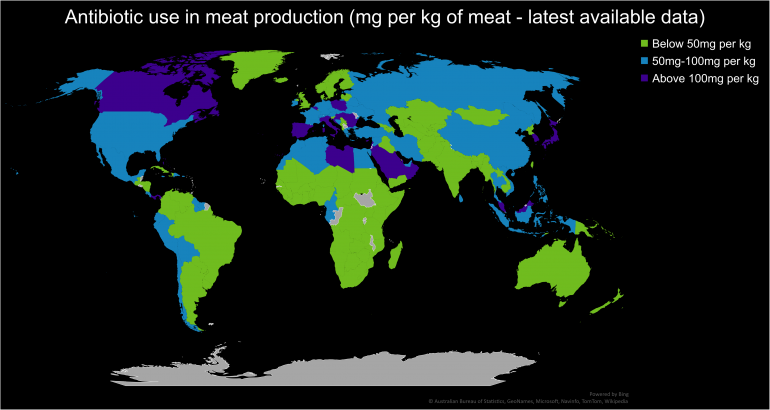Question:
What levels of antibiotics are used in meat production in different countries around the world?
Answer:
There is a great deal of variation in the level of antibiotics used in meat production around the world. Comparing the milligrams of antibiotics per kilogram of meat produced, this ranges from very low levels in countries such as the Nordics (Norway 3mg/kg, Iceland 5mg/kg, Sweden 12mg/kg) to some very high levels particularly in Southern European countries (Italy 322mg/kg, Spain 402mg/kg, Cyprus 434mg/kg).
In our recent VitaMins Health article, we covered the growing threat of antimicrobial resistance (AMR) on longevity. AMR is viewed by the World Health Organisation as one of the top 10 global health threats to humanity, with the reduction of the global use of antibiotics key to tackling AMR. In the US more antibiotics are sold for their use in animals than in humans and in 2016 the UN recognised the inappropriate use of antimicrobials in animals as a leading cause of rising AMR.
To combat the rise in AMR, a proposed target of 50mg/kg per year has been suggested. The chart below shows how different countries are progressing towards this goal.

Source: Data downloaded from Our World in Data on November 11, 2021 https://ourworldindata.org/ant.... The most recent data available for each country is presented in the chart: 2016 for the UK; 2015 for Austria, Belgium, Bulgaria, Croatia, Cyprus, Czech Republic, Denmark, Estonia, Finland, France, Germany, Greece, Hungary, Iceland, Ireland, Italy, Latvia, Lithuania, Luxembourg, Netherlands, Norway, Poland, Portugal, Romania, Slovakia, Slovenia, Span, Sweden, Switzerland; 2010 for all other countries where data is shown.
Key takeaways
- There is a large variation in the amount of antibiotics used in meat production around the world.
- Of Club Vita’s operating territories, the UK is leading the pack with 45mg/kg following regulatory efforts over recent years. In comparison, the US is currently using 85mg/kg and Canada 112mg/kg.
- As consumers we can put pressure on food producers by reading the labels and adjusting our purchasing choices accordingly.
The key questions are:
- How will the levels of antibiotics used in meat production change in the future?
- Will future changes be able to reduce the growth of AMR?
What do you think?
Need more information?
If you have any further questions our team would be happy to help you.




